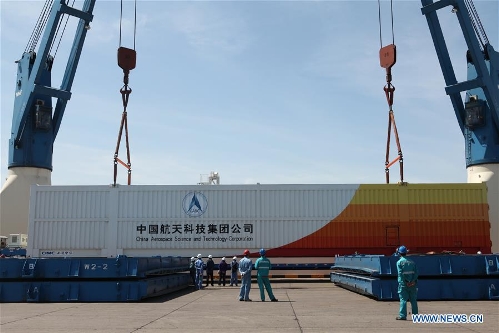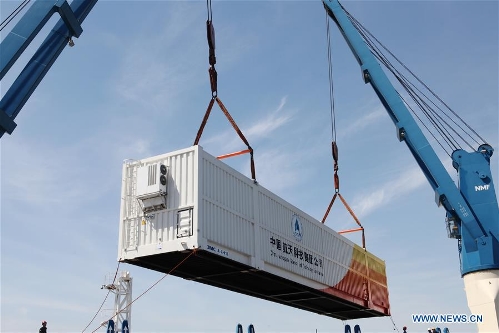 Big discovery
Big discovery:
When two black holes collided some 1.3 billion years ago, the joining
of those two great masses sent forth a wobble that hurtled through space
and reached Earth on Sept 14, 2015, when it was picked up by
sophisticated instruments - Reuters
From Aristotle to Einstein, the world's greatest minds have long theorized about gravity. Here are the highlights, and where the study of gravity is headed next. (Gillian Brockell,Joel Achenbach/TWP)
The “chirp” is bright and bird-like, its pitch rising at the end as though it’s asking a question. To an untrained ear, it resembles a sound effect from a video game more than the faint, billion-year-old echo of the collision of two black holes.
But to the trained ear of experimental physicist, it is the opening note of a cosmic symphony. On Thursday, for the first time in history, scientists announced that they are able to hear the ripples in the space-time continuum that are produced by cosmic events — called gravitational waves. The discovery opens up a new field of scientific research, one in which physicists listen for the secrets of the universe rather than looking for them.
[Everything you need to know about gravitation waves (in gifs)]
“Until this moment, we had our eyes on the sky and we couldn’t hear the music,” said Columbia University astrophysicist Szabolcs Márka, a member of the discovery team, according to the Associated Press. “The skies will never be the same.”
Scientists from the Laser Interferometer Gravitational-wave Observatory (LIGO) announced on Feb. 11 that they have detected gravitational waves, ushering in a new era in the way humans can observe the universe. (Reuters)
Thursday’s moment of revelation has its roots a century earlier, in 1916, when Albert Einstein predicted the existence of gravitational waves as part of his ground-breaking theory of general relativity. The intervening years included brush-offs and boondoggles, false hope, reversals of opinion, an unlikely decision to take a $272 million risk, and a flash of serendipity that seemed too miraculous to be real — but wasn’t.
Here’s how it all happened.
[LIGO’s success was built on many failures]
In 1915, Einstein gave a series of lectures on his General Theory of Relativity, asserting that space and time form a continuum that gets distorted by anything with mass. The effect of that warping is gravity — the force that compels everything, from light to planets to apples dropping from a tree, to follow a curved path through space.
Gravitational waves, which he proposed the following year, are something of a corollary to that theory. If spacetime is the fabric of the cosmos, then huge events in the cosmos — like a pair of black holes banging into each other — must send ripples through it, the way the fabric of a trampoline would vibrate if you bounced two bowling balls onto it. Those ripples are gravitational waves, and they’re all around us, causing time and space to minutely squeeze and expand without us ever noticing. They’re so weak as to be almost undetectable, and yet, according to Einstein’s math at least, they must be there.
But like the entire theory of general relativity, gravitational waves were just a thought experiment, just equations on paper, still unproven by real-world events. And both were controversial. Some people believe that the initial skepticism about Einstein’s theory, plus blatant anti-Semitism — some prominent German physicists called it “world-bluffing Jewish physics,” according to Discover Magazine — explain why he never got the Nobel Prize for it. (He was eventually awarded the
the 1921 Nobel Prize in Physics for his explanation of the photoelectric effect.)
A century after Einstein hypothesized that gravitational waves may exist, scientists who have been trying to track such waves are gearing up for a news conference. (Reuters)
So scientists came up with a series of tests of general relativity. The biggest took place in 1919, when British physicist Sir Arthur Eddington took advantage of a solar eclipse to see if light from stars bent as it made its way around the sun (as Einstein said it should). It did, surprising Einstein not in the slightest.
According to
Cosmos, when he was asked what he would have done if the measurements had discredited his theory, the famous physicist replied: “In that case, I would have to feel sorry for God, because the theory is correct.”
[Inside LIGO: Physicists detect gravitational waves]
One by one, successive experiments proved other aspects of general relativity to be true, until all but one were validated. No one, not even Einstein, could find evidence of gravitational waves. Eddington, who so enthusiastically demonstrated Einstein’s theory of relativity, declared that gravitational waves were a mathematical phantom, rather than a physical phenomenon. The only attribute the waves seemed to have, he snidely remarked,
was the ability to travel “at the speed of thought.” In the end, Einstein himself had doubts. Twice he reversed himself and declared that gravitational waves were nonexistent, before turning another about-face and concluding that they were real.
 A
small statue of Albert Einstein is seen at the Einstein Archives of
Hebrew University in Jerusalem on Feb. 11, 2016, during presentation of
the original 100-year-old documents of Einstein’s prediction of the
existence of gravitational waves.(Abir Sultan/EPA)
A
small statue of Albert Einstein is seen at the Einstein Archives of
Hebrew University in Jerusalem on Feb. 11, 2016, during presentation of
the original 100-year-old documents of Einstein’s prediction of the
existence of gravitational waves.(Abir Sultan/EPA)
Time passed. A global depression happened, followed by a global war. A reeling and then resurgent world turned its scientific eye toward other prizes: bombs, rockets, a polio vaccine. Then, in the 1960s, an engineering professor at the University of Maryland decided he would try his hand at capturing the waves that had so eluded the man who first conceived of them.
The engineer, Joe Weber, set up two aluminum cylinders in vacuums in labs in Maryland and Chicago. The tiny ripples of gravitational waves would cause the bars to ring like a bell, he reasoned, and if both bars rang at once, then he must have found something.
Weber declared his first discovery in 1969, according to the New Yorker. The news was met with celebration, then skepticism, as other laboratories around the country failed to replicate his experiment. Weber never gave up on his project, continuing to claim new detections until he died in 2000. But others did. It didn’t help that gravitational waves supposedly detected by a South Pole telescope in 2014 turned out to be
merely a product of cosmic dust.
People were inclined to believe, physicist Rainer Weiss told the New Yorker, that gravitational-wave hunters were “all liars and not careful, and God knows what.”
[A brief history of gravity, gravitational waves and LIGO]
Weiss would prove them wrong. Now 83, he was a professor at the Massachusetts Institute of Technology when Weber first started publishing his purported discoveries.
“I couldn’t for the life of me understand the thing he was doing,” he said in a Q&A for the university website. “That was my quandary at the time, and that’s when the invention was made.”
Weiss tried to think of the simplest way to explain to his students how gravitational waves might be detected, and came up with this: Build an immense, L-shaped tunnel with each leg an equal length and a mirror at the far ends, then install two lasers in the crook of the L. The beams of light should travel down the tunnels, bounce off the mirrors, and return to their origin at the same time. But if a gravitational wave was passing through, spacetime would be slightly distorted, and one light beam would arrive before the other. If you then measure that discrepancy, you can figure out the shape of the wave, then play it back as audio. Suddenly, you’re listening to a recording of the universe.
That idea would eventually become the
Laser Interferometer Gravitational-Wave Observatory (LIGO), the pair of colossal facilities in Washington and Louisiana where the discovery announced Thursday was made.
But not without overcoming quite a few obstacles.
For one thing, even though gravitational waves are all around us, only the most profound events in the universe produce ripples dramatic enough to be measurable on Earth — and even those are very, very faint. For another, an instrument of the size and strength that Weiss desired would require a host of innovations that hadn’t even been created yet: state-of-the-art mirrors, advanced lasers, supremely powerful vacuums, a way to isolate the instruments from even the faintest outside interference that was better than anything that had existed before. The L tunnel would also have to be long — we’re talking miles here — in order for the misalignment of the light beams to be detectable. Building this instrument was not going to be easy, and it was not going to be cheap.
And there would need to be two of them. The principles of good scientific inquiry, which requires that results be duplicated, demanded it.
It took a few decades and a number of proposals, but in 1990 the National Science Foundation finally bit. Weiss and his colleagues could have $272 million for their research.
“It should never have been built,” Rich Isaacson, a program officer at the National Science Foundation at the time, told the New Yorker. “There was every reason to imagine [LIGO] was going to fail,” he also said.
But it didn’t. Twenty-one years and several upgrades after ground was broken on the first LIGO lab, the instruments finally found something on Sept. 14, 2015.
Like most scientific discoveries, this one started not with a “Eureka,” but a “Huh, that’s weird.”
That’s what Marco Drago, a soft-spoken post-doc sitting at a desk in Hanover, Germany, thought when he saw an email pop up in his inbox. It was from a computer program that sorts through data from LIGO to detect evidence of gravitational waves. Drago gets those messages almost daily, he told
Science Magazine — anytime the program picks up an interesting-seeming signal.
This was a big one. Almost too big, considering that Sept. 14 was the very first day of official observations for the newly revamped LIGO instruments. Drago could only assume that the pronounced blip in his data was a “blind injection,” an artificial signal introduced to the system to keep researchers on their toes, make sure that they’re able to treat an apparently exciting development with the appropriate amount of scrutiny.
But the injection system wasn’t supposed to be running yet, since research had just started. After about an hour of seeking some other explanation, Drago sent an email to the whole LIGO collaboration, he told Science: Was there an injection today? No, said an email sent that afternoon. Something else must have caused it.
But no one had an explanation for the signal. Unless, of course, it was what they were looking for all along.
 An
aerial photo shows Laser Interferometer Gravitational-Wave Observatory
(LIGO) Hanford laboratory detector site near Hanford, Washington in this
undated photo released by Caltech/MIT/LIGO Laboratory on Feb. 8, 2016.
(Caltech/MIT/LIGO Laboratory/Handout via Reuters)
An
aerial photo shows Laser Interferometer Gravitational-Wave Observatory
(LIGO) Hanford laboratory detector site near Hanford, Washington in this
undated photo released by Caltech/MIT/LIGO Laboratory on Feb. 8, 2016.
(Caltech/MIT/LIGO Laboratory/Handout via Reuters)
Chad Hanna, an assistant professor of physics at Pennsylvania State University who was also part of the LIGO team, blanched as he read the successive emails about the weird signal. He and his colleagues had joked about their instruments detecting something on Day One, he wrote for
the Conversation, but no one imagined that it could really happen.
“My reaction was, ‘Wow!’” LIGO executive director David Reitze said Thursday, as he recalled seeing the data for the first time. “I couldn’t believe it.”
Yet, as the weeks wore on and after an exhaustive battery of tests — including an investigation to make sure that the signal wasn’t the product of some ill-conceived prank or hoax — all the other possible sources of the signal were rejected. Only one remained: Long ago and far from Earth, a pair of black holes began spiraling around one another, getting closer and closer, moving faster and faster, whirling the spacetime around them, until, suddenly, they collided. A billion years later, a ripple from that dramatic collision passed through the two LIGO facilities, first in Louisiana, then, after 7 milliseconds, in Washington.
The realization of what they’d found hit the LIGO collaborators differently. For some, it was a vindication — for themselves as well as the men who inspired them: “Einstein would be beaming,” Kip Thorne, a Cal-Tech astrophysicist and co-founder of the project with Weiss, said at the news conference Thursday.
After the briefing, he also credited Weber, the UMD professor: “It does validate Weber in a way that’s significant. He was the only person in that era who thought that this could be possible.”
Thorne told
Scientific American that he’s feeling a sense of “profound satisfaction” about the discovery. “I knew today would come and it finally did,” he said.
For Weiss, who had invested half his life in the search for gravitational waves, there’s just an overpowering sense of relief.
“There’s a monkey that’s been sitting on my shoulder for 40 years, and he’s been nattering in my ear and saying, ‘Ehhh, how do you know this is really going to work? You’ve gotten a whole bunch of people involved. Suppose it never works right?'” he told MIT. “And suddenly, he’s jumped off.”
But the mood Thursday was mostly one of awe, and joy, and excitement to see what comes next.
Neil deGrasse Tyson, director of the Hayden Planetarium at the American Museum of Natural History and celebrity astrophysicist, joined a gathering of Columbia University scientists who had been involved in the LIGO project. They cheered as they watched the Washington, D.C., news conference where Reitze announced the find.
“One hundred years feels like a lifetime, but over the course of scientific exploration it’s not that long,” Tyson told
Scientific American about the long search for gravitational waves. “I lay awake at night wondering what brilliant thoughts people have today that will take 100 years to reveal themselves.”
New discoveries about Jupiter’s Great Red Spot and the latest images of Pluto.
The collision of two black holes holes - a tremendously powerful event detected for the first time ever by the Laser Interferometer Gravitational-Wave Observatory (LIGO) is seen in this still image from a computer simulation released on Feb. 11. Scientists have for the first time detected gravitational waves, ripples in space and time hypothesized by Albert Einstein a century ago, in a landmark discovery that opens a new window for studying the cosmos. Caltech/MIT/LIGO Laboratory/Reuters
Sources:
Washington Post

























There’s a wonderful education film about bringing a new life form back from space — it’s calle d “Life.” Everyone should watch this for context. And the Chinese have
Source link